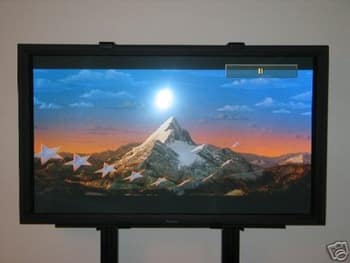Plasma displays were the first HD TV types to hit the markets, and they continue to remain popular today. While there is a lot to like about them, there are some negatives to keep in mind when considering the purchase of a plasma display television as well. Let’s look at some pros and cons of plasma TVs..
Pros of Plasma TVs
1.) Resolution/Picture Quality. One of the main things plasma displays stand out for is the great picture quality. It supersedes that of the LCD with a brilliant color array, which accentuates the reds, blues, and green subpixels. Pair that with a 1080 resolution, and the result is one fantastic display.
2.) No Motion blurring. Unlike LCD counterparts, plasma TVs do not have motion blurriness. The LCD displays cannot turn pixels on and off as quickly, whereas the fluorescent phosphor coating in the subpixels takes only a nanosecond to glow and can stop just as fast when necessary. This means when the images change quickly, the pixel cells change with them as they need very little time to do so.
3.) Contrast balance. The plasma cells on the screen have natural and vibrant dark colors, allowing for the picture to display with better contrast when displaying darker images on the screen. The cells also function independently of one another, so they do not rely on each other’s brightness, making all the cells bright, so no one is brighter than the rest.
4.) Screen Size. Those who love big screens tend to be drawn to plasma TVs because these tend to be significant in size. The smallest plasma tv on the market is 42 inches.
5.) Wide Viewing Angle. Because a plasma display does not rely on filtering to manage the light on the screen, the pictures can be viewed at wide angles without loss of picture integrity.
Cons of Plasma TVs
1.) Shorter Lifespan. The phosphors in the cells exhibit extreme brightness, but they also wear and dim relatively quickly, so the image after a time displays not quite as bright as it once did.
2.) Burn-In. Some plasma TVs (mostly older models) have an issue with Burn-In. If a display is paused, for example, when it is unpaused, the image may remain “burned-in” to the screen. Depending on the burn-in severity, the remnants of the previously static display may remain for minutes (or permanently in old models) long after the images on the screen started moving.
3.) Fragile. Plasma TVs are susceptible and easily damaged. Once pixels burn out, they cannot be repaired like on an LCD TV.
4.) Brightness. In a room with a lot of light, plasmas tend to be harder to see from a brightness perspective. This is because the glossy reflective screen overlaying the plasma cells is thoughtful, and messes with the view in when hit by external light.
5.) Energy Consumption. Plasma TVs consume significantly more energy than other types of displays, so they would raise electricity bills if used frequently.
6.) Price. The fantastic display comes with a price. Most plasma TVs tend to cost more than their LCD and LED counterparts.
- Tulip Mania – The Story of One of History’s Worst Financial Bubbles - May 15, 2022
- The True Story of Rapunzel - February 22, 2022
- The Blue Fugates: A Kentucky Family Born with Blue Skin - August 17, 2021
